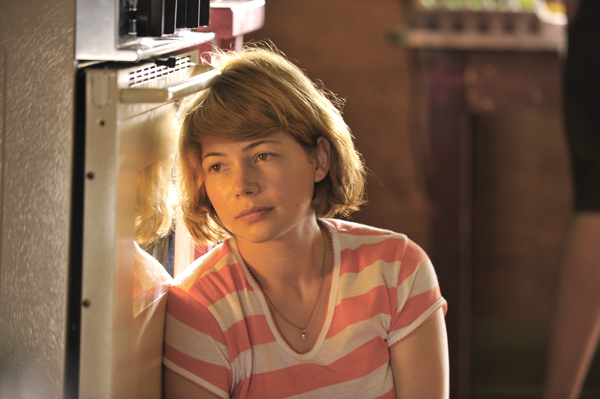
Michelle Williams in TAKE THIS WALTZ (Magnolia Pictures)
Take This Waltz is bathed in sunshine. In fact, almost every scene is shot in gorgeous sunlight. For a film that deals with some serious issues, such as adultery and alcohol abuse, it is riddled with bright oranges, reds, and blues. This is most prominent in the wardrobe of Margot (Michelle Williams), a young married woman struggling to understand her intense, romantic feelings for her across-the-street neighbor.
Margot meets Daniel (Luke Kirby), a rickshaw driver and artist, while on a business trip in Nova Scotia. She works for the Canadian parks service, writing about various national sites for their website. They meet again on a connecting flight from Montreal to Toronto. After realizing this brief encounter may not be so brief, since Daniel lives on her street, Margot begins dealing with the fact that her feelings for Daniel may strongly affect her marriage.
Seth Rogen plays Margot’s husband, Lou, a sweetly caring man who is in the process of writing a cookbook solely focused on chicken recipes. Margot is also close with Lou’s family, including his sister Geraldine (Sarah Silverman), a recovering alcoholic. It’s difficult to see how Margot can be so unhappy in what appears to be a very loving marriage and family. In fact, her unhappiness is vague and appears to go beyond her romantic struggles. She knows Lou is a great husband, and she feels guilty for her feelings for Daniel, attempting (and failing) to keep him at a distance for much of the film. The more complicated Margot’s relationship with Daniel becomes, the harder she clings to Lou, both emotionally and physically.
This is where Take This Waltz runs into its biggest issues: what is the source of Margot’s unhappiness, and why does she think Daniel can make her feel happier? These are the main questions the film asks, but doesn’t provide enough solid information to answer. The bond between Margot and Daniel emerges quickly, but the slow build-up of meaningful meetings and conversations is somewhat empty. There is a palpable sexual attraction, and the hint of something more, but the story never quite makes that clear. This is especially true against the detailed relationship Margot has with Lou, a marriage fully fleshed out, complete with inside jokes and loving pranks. Rogen portrays Lou as so sweet and understanding that it would be tricky to comprehend how Margot could consider leaving him even if her relationship with Daniel was more defined.
In addition to the candy-colored mise en scène, Take This Waltz has many of the idiosyncrasies one would think to find in a quirky romantic comedy: an interesting soundtrack (including the Leonard Cohen song from which the film gains its title), moments of hilarious embarrassment, and eccentric characters. This is true of Margot herself, portrayed by Williams with such an intriguing strangeness. It’s unfortunate that her eccentricities, such as her childlike behavior—her juvenile sense of humor and clinginess towards Lou—are never fully linked to her actions. I was hoping this juxtaposition of the melancholy with which the film depicts Margot and her relationships and the film’s lighter tone would reveal something deeper about the characters. Instead, I remained perplexed by their motives. Perhaps the purpose of the film is to keep Margot’s true feelings somewhat buried. If so, it became frustrating to watch a character so seemingly full of depth, yet so remote.
Despite the conflicting tone, I was completely drawn in by the look of the film. Director Sarah Polley (her first film since 2006’s Away From Her) has an apparent love for her Toronto hometown. (Having never been to the city myself, the setting made me think I really need to visit it someday.) Even though I was ready to leave Margot and her troubles behind, I could definitely spend some more time in her vibrant world.






Leave A Comment